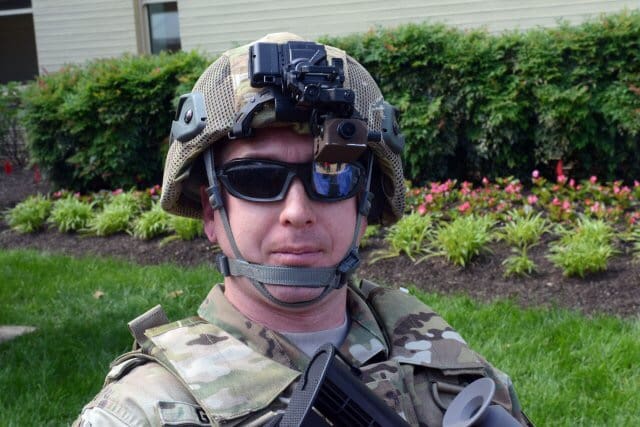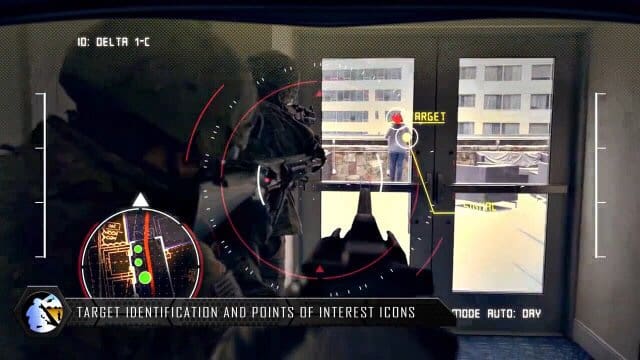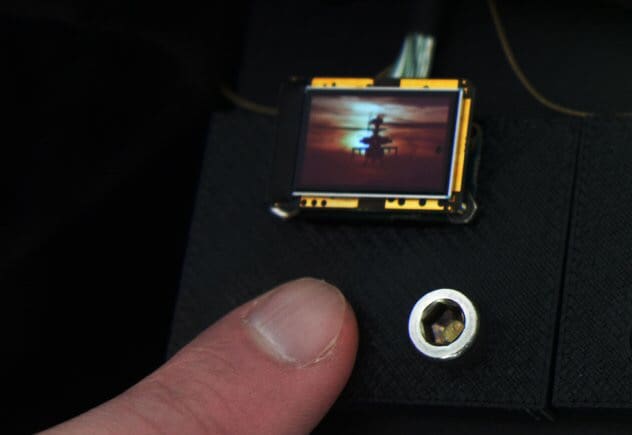WASHINGTON (Army News Service) — A novel technology called “Tactical Augmented Reality,” or TAR, is now helping Soldiers precisely locate their positions, as well as the locations of friends and foes, said Richard Nabors.
It even enables them to see in the dark, all with a heads-up display device that looks like night-vision goggles, or NGV, he added. So in essence, TAR replaces NVG, GPS, plus it does much more.
Nabors, an associate for strategic planning at U.S. Army Research, Development and Engineering Command’s Communications-Electronics Research, Development and Engineering Center, or CERDEC, spoke about TAR at the Pentagon’s Lab Day, Thursday.
Currently, most Soldiers use a hand-held GPS system that approximates their position, he said, but only if their device is geo-registered to their location.
Geo-registration is the alignment of an observed image with a geodetically-calibrated reference image.
TAR does the geo-registration automatically, he said.
Staff Sgt. Ronald Geer, a counterterrorism non-commissioned officer at CERDEC’s Night Vision and Electronics Sensors Directorate, said that with TAR, Soldiers don’t have to look down at their GPS device. In fact, they no longer need a separate GPS device because with TAR, the image is in the eyepiece, which is mounted to the Soldier’s helmet in the same way NVG is mounted.
So what they would see, he said, is the terrain in front of them, overlaid with a map.
TAR is also designed to be used both day and night, he added.

A novel technology called “Tactical Augmented Reality,” or TAR, is now helping Soldiers precisely locate their positions, as well as the locations of friends and foes. The technology enables a tiny, heads-up display attached to the helmet, as modeled by Staff Sgt. Ronald Geer, a counterterrorism non-commissioned officer at CERDEC’s Night Vision and Electronics Sensors Directorate, during Lab Day at the Pentagon, May 18, 2017. (Photo Credit: David Vergun)
Furthermore, Geer pointed out that the eyepiece is connected wirelessly to a tablet the Soldiers wear on their waist and it’s wirelessly connected to a thermal site mounted on their rifle or carbine.
If a Soldier is pointing his or her weapon, the image of the target, plus other details like the distance to target, can be seen through the eyepiece.
The eyepiece even has a split screen, so for example, if the rifle is pointed rearward and the Soldier is looking forward, the image shows both views, he said.
Also, a Soldier behind a wall or other obstacle could lift the rifle over the wall and see through the sites via the heads-up display without exposing his or her head.
Finally, Geer said that TAR’s wireless system allows a Soldier to share his or her images with other members of the squad. The tablet allows Soldiers to input information they need or to share their own information with others in their squad.
TECHNOLOGY BREAKTHROUGH
David Fellowes, an electronics engineer at CERDEC, said that the key technological breakthrough was miniaturizing the image to fit into the tiny one-inch-by-one-inch eyepiece.
Current commercial technology compresses images into sizes small enough to fit into tablet and cell phone-sized windows, but getting a high-definition image into the very tiny eyepiece was a challenge that could not be met with commercial, off-the-shelf hardware.
Since about 2008, CERDEC, the Army Research Laboratory and industry have been working to make this miniaturization happen, he said.
By about 2010, the image was compressed enough to be shown in black and white, as well as a greenish monochrome version, he said.
Those systems have already been fielded to certain units, he said.
Currently, CERDEC is working on producing more advanced versions that are in full color and have a brightness display that can even be seen in daylight. The current monochrome versions are also bright enough to be seen in daylight.
Fellowes said he’s not sure when those will be manufactured and fielded, but during user testing, Soldiers expressed their deep appreciation of the image sharpness and contrast.
He added that the TARs will provide Soldiers with a much higher level of situational awareness than they currently have and he said he fully expects that the devices will save lives and contribute to mission success




The image is higher quality but we were doing this in the battle lab in 2003.
It was an offshoot of Land Warrior. They promised full fielding was around the corner also.
SOCOM is doing something already with the fielding of eCOTI.
This cheese ball commercial was funny until I realized it was tax payer funded and probably cost millions.
So it wasn’t just me who saw this in a “1st world-like” city w/ US Army (regulars) taking down “citizens”??? 1st part creepy, as in “domestic” operations, 2nd part, absurd w/ typical office pouge-like “serious” attitude NCO “in charge”. What a joke! Can’t wait until an EMP hits only those that “know” will show!
SHOW!
If you watch it through to the Zoom out at the end they are using either Jakarta or Bangkok as the AOR. but the City is more of a composite taking buildings from around the World and CGI’ing a unified Skyline for a Megacity.
The Army has been worried that they might need to fight in real cities in the near future. Mexico city, Taipei, Dubai, Seoul, Karachi, Manila, Shanghai, Beijing, Lagos, Dhaka, Lahore, Kinshasa even Tehran All sit as possible US AOR’s depending on events in the next decade.
These were based on low intensity warfare scenarios
EMP is over stated, To generate an EMP basically comes in 2 forms. First is a localized event a jammer. Such a device can interfere with Electronics but if the Device is deactivated every thing returns to normal. second is a thermonuclear event In which case the effects of the Blast would likely render the city a ruin. and Again the effects are temporary.
I’m looking the bigger picture and not the tit-for-tat techno-jumble. Uniformed regulars in a low-vis environment is absurd and I was equating it to a 1st world-city like how we describe the USA. Scary and scary! I’ll leave the “office pouges” alone on this comment since no one has the fuzz on their inch worm to touch it (my original comment, not your own “inch-worm”).
Well Ed I was only commenting on two parts of it, because I do have a degree of Agreement with you.
The Over command bit was ripped from Drone ops and Does not seem well suited to Infantry operations.
The display system and AR makes a degree of Sense especially if it works with NV, Thermal gear and rifle sighting as a evolutionary step.
but not the higher up top heavy command. I mean if you have lots of units operating across a city at once you are going to have all kinds of issues of bandwidth and conflicts of command. Also the Search op has a flaw in that you are going to have places where the maps are wrong. the Data is out of date and Intelligence messed up. This whole concept is based on the assumptions of a Low intensity conflict and a flawless command structure. That just begs for something to go wrong.
Ed I think you have your tinfoil hat on a little too tight. The US isn’t the only country with first world cities. There is a real concern with TTPs of fighting in mega cities. Also, low-vis and low intensity are two radically different things. Conventional regular units do low intensity all the time and you will see it happening more often as we distance ourselves from bigger conflicts such as Afghan and Iraq. Before you freak out over something new to you, take some time to understand it first
Whooaaaa, easy there Jakey! I get it that context and meaning can be lost in text/email like comments but I think your taking it a tad too far. Thank you for the insult that you laid on me thinking there are no other “1st world” cities outside the US, I was making a reference that it “resembled” a city, like you find here in the States. It also seems the one “freaking out” is you here, It is a crappy commercial/AD set-up that most agree here reeks of Big-Army phucking sh*t up! It maybe you who has their “hat” on too tight to take a comment someone made and have a tizzy! At least an educated and respectful person like “Lcon” have a back and forth convo-discussion.
Grow the Phuck up Jakey boy!
Dude, they even gave you the map in the end – it’s Bangkok, Thailand. However, a smaller number of high-rise buildings look more like Pattaya – only a few of them, comparing to a huge Manhattan-like area of Bangkok. Have you ever been in Asia? Many cities there have larger downtown areas and higher buildings than Austin, TX and Houston, TX you most likely very familiar with.
If it was not another colossal waste of money it would really be funny
Yeesh, just cut the bullshit and give us Iron Man suits. Is that too much to ask?
Or that suit in GI JOE movie, about as realistic as the cartoon or what “they-re” going for with the “future soldier” BS!
You know, I have one simple request. And that is to have sharks with frickin’ laser beams attached to their heads! Now evidently my cycloptic colleague informs me that that cannot be done. Ah, would you remind me what I pay you people for, honestly? Throw me a bone here! What do we have?
You win.
“We have Sea-Bass.”
“Are they ill tempered?”
“Yes, very.”
Well they didn’t Hollywood this at all, did they?
SSD, if you haven’t read David Drake, you should. This tech is a step in the direction of his combat helmet, which had eye pro, nose filters, blast dampening, flash protection, comms, a limited AI, and an internal display over which the user could designate targets/friendlies, maps and night/IR thermographic displays.
All we need now is the 1cm iridium powergun.
Guys would complain because they couldn’t get a good cheek weld.
Looks fucking astounding. I hope it’s ruggedized as hell and has incredible redundancy built in. That’s a lot of critical functionality to lose due to a single failure.
Where’s his rear sight?
Bet it works great with the xm-25, makes about as much sense . Yahoo! lets waste another kazillion dollars
US Army killed the XM25 a few weeks ago.
I like the sound of a crappy high-voltage power supply warming-up when display switches to night vision mode.
When will the Call of Duty version be out?
My question or better concern perhaps? Is, are we becoming too reliant or dependant on technology and lapsing in hands on skills?
For instance, how many kids rely on digital time and many are lost if telling time on an old school clock? I have guys in my auto business that can’t drive a 6 speed! So what happens if soldiers become too reliant on the tech side and when it goes down they’re lost or ill informed on back up plan?
We taught our kids how to read a good ol paper map before they use Google maps because it’s so sad seeing kids look at a paper map and have no clue how it works.
Technology is a tool, you can use it to do something useful or just drop it on your leg, cut away your fingers or poke yourself in the eye. Not harming yourself is a question of common sense and training.
Regarding of dial clock and paper map, that’s a kind of odd example. Like, if there are almost no dial clocks around, why’d you really need to be able to read it? Just because your father and grandfather were doing it? This skill could still be used, but rarely. The paper map is not really different from a digital one in terms of presentation. And if some “kid” can’t see that it’s the same thing, he’s probably just dumb (it happens quite often).
So, “too much” or “just right” is a matter of context (I mean, it is not universal) and a result of receiving a proper training. Technology is neutral.
No one else noticed the flagging at the beginning of the video? 01:11 Professionalism, defined.
Lets hope the security on that tech is locked down tight, would hate to see friendly fire incidents because a hacker made the the tactical augmented reality become tactical altered reality.